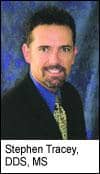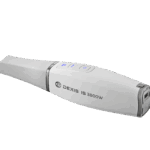by Michael C. Alpern, DDS, MS
How the Bonded Rapid Palatal Expansion Bite Plane System can turn big problems into small ones.

With proper diagnosis and application, early interceptive orthodontic treatment can be important in promoting normal, healthy, and attractive facial growth of selected patients. That said, early orthodontic interceptive treatment is relatively easy on patients and hard on the orthodontist and the parents. This article will address the reasoning behind early treatment, as well as its benefits and risks.
The primary justifications for early treatment are correction of a crossbite or correction of a major problem that, if left uncorrected, will result in poor growth patterns.
The Bonded Rapid Palatal Expansion Bite Plane System
My approach to both of these is the Bonded Rapid Palatal Expansion (RPE) Bite Plane System. This system has the potential to change a number of important functional and skeletal growth problems, as well as correct crossbites.
The Bonded RPE Bite Plane System can do the following:
- Increase functional tongue room without surgery. Increased functional tongue room can promote normal tongue posture and prevent anterior tongue thrusting and resulting anterior open bites.
- Increase the ability of patients to breathe easier through their nose (in 90% of my patients, according to a 10-year unpublished study). Other studies do not agree, but do not use palatal expansion with bite planes. Regardless, nasal breathing is important in facial development. Mouth breathing is abnormal and can contribute to maxillary and mandibular width deficiency and diminished functional tongue room.
- Correct or eliminate anterior and posterior crossbites. Anterior crossbites can be corrected by adding anterior lingual whip springs to the anterior arms of the palatal expander. The bite planes temporarily open the bite, permitting clearance to “jump” or permitting unencumbered freedom of movement of a maxillary lingual tooth buccally or anteriorly without occlusal interferences.
- Redirect marked vertical growth patterns. Bonded palatal expanders are activated (by turning the screw) once per day for a period of 4 to 6 weeks. Then, we secure the expansion screw device with a stainless steel ligature and cover it with cured Triad for tongue comfort. The expander then stays in place for 4 months. This adds up to a total of 5 months in which selective bite plane thickness can orthopaedically restrain and/or redirect excessive vertical growth. In hyperdivergent (vertical growers) we build the bonded expanders bite planes more thickly (especially in back). These thick bite planes invade the freeway space. Most patients can exert from 250 to 350 pounds per square inch of biting force. As the patient slightly clenches on the posterior, thick bite planes, orthopaedic forces are created, which restrain vertical growth and intrude posterior teeth (for closing anterior open bites).
When we remove the palatal expander, we immediately place a palatal bar from maxillary first molar to first molar and bond flowable composite to the posterior molars. Thus, the posterior vertical restraint is continued after the expansion device has been removed.

Michael C. Alpern, DDS, MS
Another key component to this system is adding buccal external hooks to the expanders during construction. At the completion of maxillary expansion, with the expansion screw ligated, we immediately begin crossbite elastics from lingual hooks on mandibular first molar bands. Thus, we begin lingual uprighting of mandibular molars that may be lingually proclined into functional tongue space. The maxillary bite planes prevent over uprighting of the mandibular molars and give simultaneous vertical control to the mandibular molars.
Normally, during palatal expansion, no other forces are placed on the palatal expander to permit maximum sutural expansion and minimum alveolar tipping. Thus, anterior whip springs or crossbite elastics are not used during this time.”
The Custom Helmet
The only exception comes from the concepts that only during maxillary palatal expansion can the maxilla be moved forward without surgery. If maxillary protraction is planned, then we build Class III protraction hooks into the palatal expander. On the day the palatal expander is bonded into place, we immediately place a custom helmet designed by my wife, Ada Hinda Alpern, RDH. The helmet is custom built by an orthodontic assistant, and as soon as the expander is bonded, we fit the helmet on the patient and demonstrate attachment of elastics from the palatal expansion Class III protraction hooks to the hooks on the helmet.
Helmet wear involves 1 pound of force per side of elastic traction during the day. When patients are upright, most of the anchorage force is against the forehead. We encourage patients to sleep on their backs so that the weight of their heads is against the back of the helmet, permitting us to apply more protraction force—up to 2 pounds per side.

Before: The patient has severe maxillary width deficiency, impacted and transposed cuspids, and marked deficient functional tongue room.

After: The patient was treated with a bonded Rapid Palatal Expansion System with crossbite hooks and protraction hooks. After palatal expansion and protraction, a Cetlin palatal bar was placed along with partial bonding in the mandibular arch. Approximately 18 months from expansion, all of the permanent teeth were bonded and a series of square wires were used to complete treatment. The impacted and transposed cuspids are in normal position and there is normal functional tongue room—all without extraction of permanent teeth.
We ask patients to wear the helmet for at least 18 to 20 hours per day for 8 weeks, and then wear it at night for 8 more weeks. Many children who are busy at school cannot complete this schedule. We have these patients wait until 1 month before school ends to come in for records and appliance construction. They then can devote the 18 to 20 hours for 8 weeks during their summer vacation. Patients and parents choose this therapy. I do not do this “to” the patient. They request it.
After Early Treatment
At the conclusion of 5 months of palatal expansion and stabilization and 5 to 6 months of a palatal bar and a banded lingual archwire, we remove the palatal bar and the mandibular lingual arch (not the bands) and place the patient in an observation period. At first, patients are seen every 6 to 8 weeks for observation of growth and development. Any minor problems with development can be handled with removable appliances.
Thus, early treatment takes approximately 1 year, and large problems have been reduced to smaller problems. Potential impacted maxillary cuspids now have adequate maxillary width for normal eruption and not impaction and/or transposition with maxillary incisors.
To read more articles by and about Alpern, in our online archives.
Later, we observe these patients every 3 months until all their permanent teeth are in with full root development. Then, full orthodontic bands and bonded brackets can be placed as the beginning of 12 to 18 months of full treatment instead of 3 to 4 years of extensive treatment. Many times, potential tooth extraction requirement can be eliminated. And, for the long term, the temporomandibular joints are more normal due to earlier correction of an occlusal trauma such as a crossbite.
In my 33-year orthodontic career, I have found that parents often forget (no matter how many times you tell them) that additional fees are required for full banded and bonded treatment following early treatment. As a result, we do not call this two-phase treatment; we base our fees on “Continuous Treatment.”
A final note on timing: Palatal expansion primarily uses the maxillary first permanent molars as the primary anchorage. Therefore, I never begin early treatment until I have full root development of the maxillary first permanent molars. To disregard this philosophy is to run the risk of marked root shortening, dilacerations, or a compromised root structure for the entire dentition.
Michael C. Alpern, DDS, MS, is in private practice in Port Charlotte, Fla. He can be reached at










